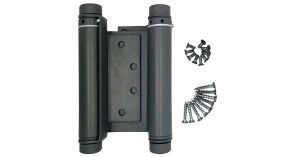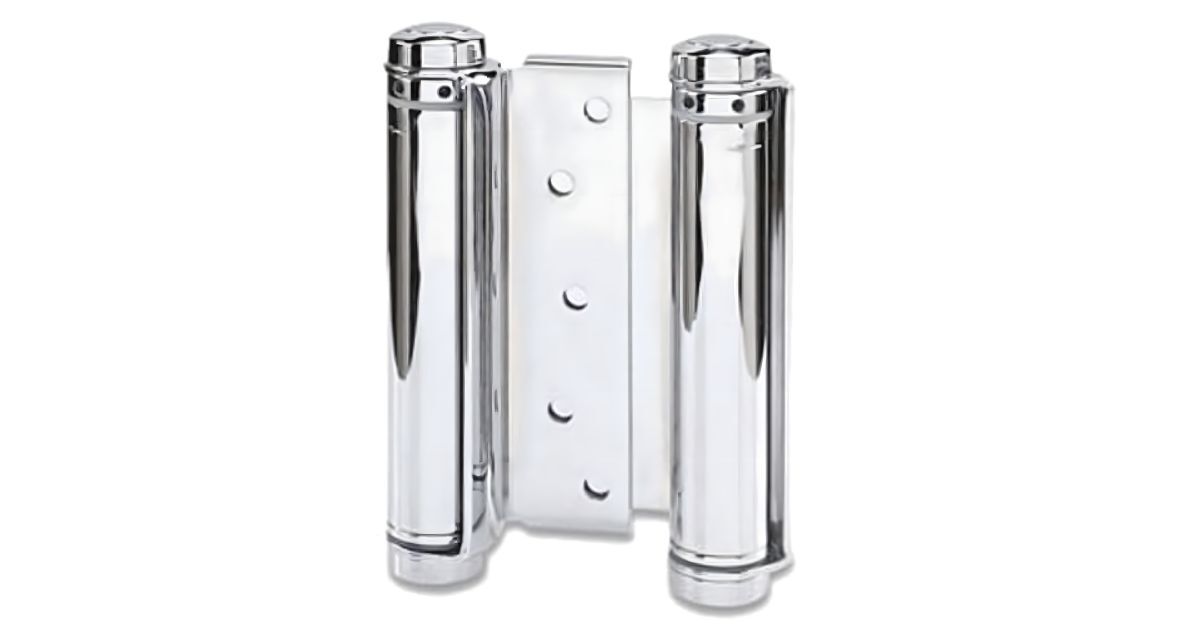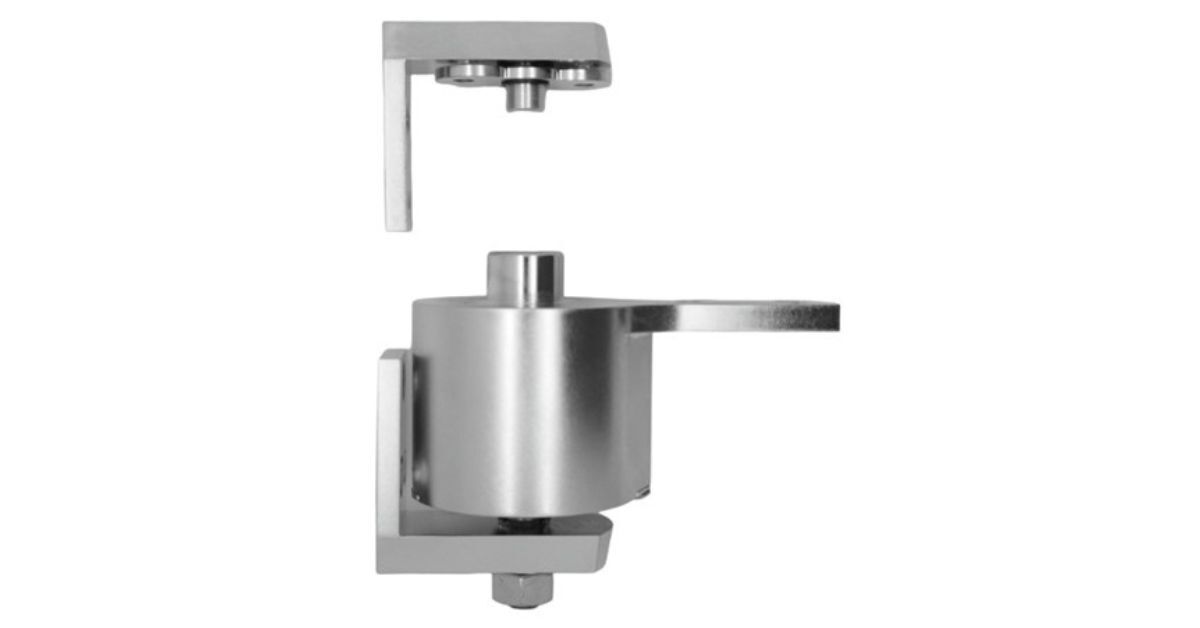
How Tension Springs Define Swinging Door Performance
Swinging doors are fundamental components in countless commercial, industrial, and residential applications. From restaurant kitchens to hospital corridors, these doors provide convenient hands-free access while maintaining necessary barriers between spaces. However, the smooth operation that users expect depends heavily on one often-overlooked component: the tension spring system.
Key Takeaways:
- Tension springs govern swinging door speed, closing force, and durability; configuration (single, dual, adjustable) drives reliability and user experience.
- Performance depends on material choice, door weight/load distribution, and environment (temperature, humidity, chemicals), which impact longevity and safety.
- Regular inspection, lubrication, and proactive replacement keep doors reliable; proper calibration supports access control, fire safety, and ADA compliance.
The relationship between tension springs and door performance extends far beyond simple opening and closing mechanics. These springs control the speed of door movement, determine closing force, influence durability, and ultimately define the user experience. Understanding how tension springs define swinging door performance helps architects, facility managers, and building owners make informed decisions about door specifications and maintenance requirements.
Understanding Tension Spring Mechanics in Door Systems
Tension springs operate on a straightforward principle: They store energy when stretched and release that energy to return to their original length. Strategically positioned springs applications control the swinging door’s return motion after being pushed open.
They overcome the initial tension in the spring system when a person pushes through a swinging door. As the door swings open, the springs stretch further, storing additional energy. Once the person passes through and releases the door, the stored spring energy pulls the door back to its closed position.
The spring’s wire diameter, coil count, and material composition determine how much force is required to open the door and how quickly it returns to the closed position. Engineers calculate these specifications based on the door’s weight, expected traffic volume, and environmental conditions.
Temperature variations significantly affect spring performance. Cold environments can make springs stiffer, requiring more force to open the door. Heat can reduce spring tension, potentially causing doors to close too slowly or incompletely.
Spring Configuration Impact on Door Movement
Different spring configurations produce distinct door behaviors. Single-spring systems provide basic return functionality but may create uneven closing speeds or incomplete closure under certain conditions. These systems work adequately for lightweight doors in low-traffic areas.
Dual-spring configurations offer improved control and redundancy. If one spring fails, the second continues to operate, preventing the door from remaining open indefinitely. This configuration also distributes the workload, potentially extending the overall system lifespan.
Adjustable spring systems allow fine-tuning of door performance after installation. These systems accommodate changes in usage patterns, seasonal temperature variations, or modifications to door weight through additional hardware or signage.
The positioning of springs within the door frame affects performance characteristics. Springs mounted closer to the hinge point require higher tension to generate an equivalent closing force. In contrast, springs positioned further from the hinge provide greater mechanical advantage but may require more complex mounting arrangements.
Material Selection and Performance Characteristics
Spring material selection directly influences performance reliability and longevity. Stainless steel springs resist corrosion and maintain consistent performance in humid or chemically aggressive environments. These springs are essential in food service areas, laboratories, and outdoor applications where exposure to moisture or cleaning chemicals is common.
Carbon steel springs offer excellent strength characteristics and cost advantages, but require protective coatings in corrosive environments. Proper surface treatments extend service life significantly, making carbon steel viable for many interior applications.
Specialized alloys provide enhanced performance in extreme temperature conditions. Commercial kitchens or industrial facilities that require high-temperature applications may require springs that maintain consistent tension despite exposure to heat.
Wire diameter affects strength and flexibility. Thicker wire provides greater force generation but reduces the spring’s ability to compress or extend. Thinner wire offers more flexibility but may not provide adequate closing force for heavier doors or high-traffic applications.
Load Distribution and Door Weight Considerations
Door weight significantly impacts spring selection and performance. Heavier doors require springs with greater tension to ensure complete closure, but excessive spring force can make doors difficult to open, particularly for elderly users or individuals with mobility limitations.
Load distribution across multiple springs requires careful engineering to prevent uneven wear patterns. Springs that bear disproportionate loads will fail prematurely, potentially causing door malfunction or safety hazards.
The door’s center of gravity affects spring performance requirements. Doors with glass panels, heavy hardware, or asymmetric weight distribution may require specialized spring configurations to achieve proper closing behavior.
Heavy-duty door hinges work in conjunction with tension springs to support door weight and facilitate smooth operation. The combination of properly specified hinges and springs ensures that doors operate reliably under their intended load conditions.
Environmental Factors Affecting Spring Performance
Humidity levels impact spring performance through corrosion effects and material property changes. High humidity environments accelerate corrosion in untreated steel springs, leading to reduced tension and eventual failure. Moisture can also affect lubricants used in spring mounting systems.
Air pressure differentials across doors create additional loads that springs must overcome. Buildings with significant heating, ventilation, and air conditioning pressure differences may require higher spring tensions to ensure doors close completely against air pressure resistance.
Frequency of use affects spring fatigue characteristics. High-traffic doors experience thousands of cycles daily, requiring springs designed for extended fatigue life. Low-traffic applications may accommodate springs with different performance characteristics optimized for cost rather than maximum cycle life.
Chemical exposure in certain environments demands specialized spring materials and protective coatings. Cleaning chemicals, industrial processes, or atmospheric contaminants can degrade standard spring materials, necessitating upgraded specifications.
Maintenance Requirements and Performance Optimization
Regular inspection of spring systems prevents unexpected failures and maintains optimal door performance. Visual examination can identify corrosion, deformation, or mounting hardware wear that could affect operation.
Lubrication of spring mounting points reduces friction and wear, extending system life. However, inappropriate lubricants can attract contaminants or degrade in certain environmental conditions, potentially worsening performance.
Spring tension adjustments may be necessary over time as springs experience settling or fatigue. Properly designed systems include adjustment mechanisms that allow fine-tuning without spring replacement.
Replacement scheduling based on cycle counts or time intervals prevents failures that could compromise security or accessibility. Proactive replacement is typically more cost-effective than emergency repairs.
Integration With Access Control and Safety Systems
Modern swinging door installations often incorporate electronic access control systems that must work harmoniously with mechanical spring systems. You must calibrate the spring tension to work effectively with electromagnetic locks, card readers, or other access control hardware.
Fire safety regulations may require specific closing speeds or forces that springs must provide reliably. Emergency egress requirements mandate that doors close completely to maintain fire barriers while remaining easy to open during evacuation scenarios.
Accessibility compliance requires springs to provide closing force without making doors excessively difficult to open. The Americans with Disabilities Act specifies maximum opening forces that influence spring selection and adjustment.
Optimizing Door Performance Through Proper Spring Selection
How tension springs define swinging door performance extends beyond basic functionality to encompass user satisfaction, energy efficiency, and long-term reliability. Proper spring selection requires a comprehensive evaluation of all operational requirements, environmental conditions, and user needs.
The investment in appropriate spring systems pays dividends through reduced maintenance costs, improved user experience, and enhanced building functionality. Understanding the critical role these components play enables better decision-making throughout the door specification, installation, and maintenance processes.
Successful swinging door performance depends on the careful integration of spring systems with other door components, environmental considerations, and user requirements. This holistic approach ensures that doors operate reliably and efficiently throughout their intended service life.


